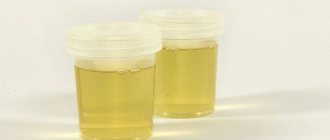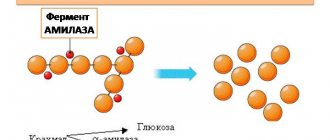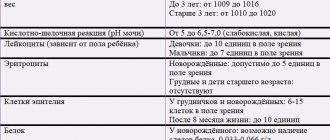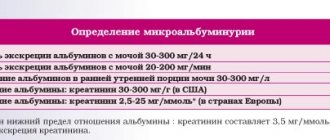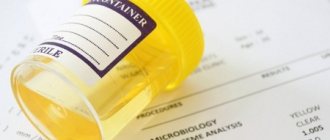How to store urine for analysis before submitting it to the laboratory
Biological materials are stored exclusively in sterile containers. It is advisable to use purchased plastic containers for biomaterials. It is allowed to take simple glass jars with tight lids and sterilize them.
Urine from infants is often collected using special urinals. The packages are designed taking into account the anatomical characteristics of boys and girls. After collection, it is important to carefully pour into a sterile jar. Some urine bags have a clasp. The finished material is handed over to them immediately.
Suitable container:
- special container;
- glass jar;
- laboratory-issued glassware;
- urinal with clasp.
Not suitable:
- Plastic container;
- plastic bags;
- unsealed containers;
- metal cans.
After collecting the urine, it is necessary to seal it, put on an additional bag, and place it in a second container. The protection will prevent accidental leakage of liquid and will seal the smell inside.
Urine for analysis is stored at a temperature of +2-4 degrees. Shelf life is from 2 to 24 hours, depending on the type of research. A sterile sealed container must be used.
Where to store urine before donation
The ideal option is to submit immediately. It is allowed to wait 1-2 hours. Transportation will take this time. Sometimes it is not possible to send urine right away. Some types of examination require the collection of daily secretions. It is important to properly preserve any material.
Storage requirements:
- temperature +2-4 degrees;
- protection from light;
- sealed, sterile container;
- strict adherence to deadlines.
It is not advisable to leave it at room conditions. At parameters above 15 degrees, sediment forms and chemical parameters change.
Urine, feces for testing, sputum, saliva, and other biomaterials cannot be frozen or filled with disinfectants or potassium permanganate.
Can urine be stored in the refrigerator?
We’ve come to the most frequently asked question: is it possible to store urine in the refrigerator before taking the test? From a temperature point of view, this is an ideal place. Just don’t put it on the door with saline solution, iodine, or other medications. Each time you open it, the temperature rises significantly.
The ideal place is the central shelf. We recommend removing the products. It is advisable to wrap the jar in a dark bag. The contents will be stored without light and will not disturb household members.
How long can urine be stored for analysis?
The duration is influenced by the purpose of the study. For some tests, biological fluid does not need to be stored at all. Only time is given for transportation. Sometimes a person comes to urinate at a laboratory reception point. He is given sterile containers and a toilet.
In a refrigerator
The material is stored in the refrigerator for the maximum period. Subject to immediate placement. Let's look at the time for the most popular methods.
Features of collection and storage of analyzes
How long does urine last in the refrigerator?
- up to 120 minutes general analysis. Only morning urine is used and immediately sent for diagnosis. The goal is to examine the chemical sediment and identify inflammatory processes;
- A three-state sample is stored for up to 24 hours. All urine from the first morning urination is collected and distributed into three containers. The purpose of the analysis is a thorough study of the course of inflammatory processes in the case of cystitis, pyelonephritis, and other genitourinary diseases;
- Material for studying according to Nechiporenko is stored for up to 60 minutes. Immediate transport required. The goal is to identify diseases of the urinary system. Usually this is pyelonephritis, cystitis;
- Urine is stored for up to 24 hours for analysis according to Kakovsky-Addis. All secretions are collected in a large container, mixed, and up to 100 ml of total liquid is taken. The goal is to identify diseases of the genitourinary system.
It is advisable to discuss the specifics of urine collection and the amount of material with your doctor.
At room temperature
How long urine can be stored for analysis at room temperature depends on the purpose of the diagnosis. Most laboratory tests require exclusively fresh urine. The maximum period is 120 minutes.
What shortens it:
- temperature above +20 degrees;
- using an unsealed container;
- lack of sterility.
Dirty dishes and improper collection distort diagnostic results. Before taking the tests, preparation is required. You should wash your genitals with a non-fragrant hygiene product. Children should not apply cream or use powder. It is prohibited to collect urine from women during menstruation.
If urine had to be stored longer than expected or the temperature was not maintained, we recommend rescheduling the test to the next day. Most laboratories accept biomaterial with an expired delivery date.
The question of how long urine can be stored for analysis is extremely important, since the quality of the material directly affects the research results.
In addition to the conditions and expiration date, it is also necessary to comply with the collection rules. All this will help to achieve the most reliable biomaterial data.
Blood analysis
- Blood is taken strictly on an empty stomach , before taking and administering medications and before X-ray, endoscopic and ultrasound examinations. At least 8 hours and no more than 14 hours of fasting, water - as usual, avoid food overload the day before, infants should not eat for 3-4 hours before blood sampling.
- Drugs that can significantly affect the results of the study should be discontinued in advance, except in cases of monitoring treatment with this drug.
- Blood for testing for substances whose concentration in the blood changes cyclically must be collected in strict accordance with physiological cycles. For example, the concentration of FSH and LH is determined on days 5-7 of the menstrual cycle.
- Avoid drinking alcohol on the eve of the test.
- Do not smoke for at least 1 hour before the test.
Properties of urine
Urine contains a large amount of organic and inorganic substances that can enter into a chemical reaction when released into the external environment, thereby changing the composition of the liquid .
In a short time, sediment forms in the urine, and this significantly reduces the quality of the material. Then bacteria appear in it, which also change the composition with the products of their vital activity.
In addition, a large amount of ammonia , which also affects the analysis results. Organic compounds quickly break down and begin to interact with each other, forming byproducts.
However, all these processes can be slowed down when it is not possible to quickly deliver urine to the laboratory.
Peculiarities
So, answering the main question, how long can a urine test cost, experts say that this biological material cannot be kept for long, but the time limits directly depend on the temperature in the room. The timing is also affected by which particular test option was recommended to the patient.
When specialists prescribe a urine test, they always tell you how long you can store the biomaterial before donating it. The properties possessed by urine passed no more than two hours ago are significantly different from those observed in the biomaterial after its expiration. Therefore, if it is kept for a long time or in inappropriate conditions, the result of the study will not be correct.
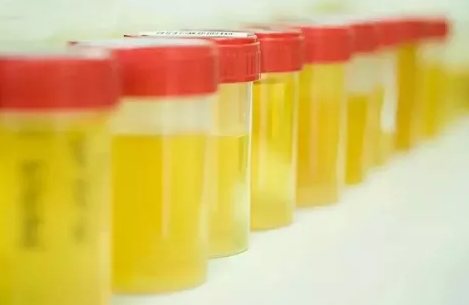
Biological material must be submitted fresh (holding period maximum 120 minutes). Source: nur.kz
Some experts advise collecting urine in the hospital toilet. Unfortunately, not all clinics have them in good condition, so it is possible that hygiene standards will not be met.
It is best to do this at home, but do not forget that urine contains a large number of compounds, as well as breakdown products of the body, for example, salts and phosphates. All substances react with each other, as well as with the environment. Therefore, it is recommended to minimize their contact, which can be done by timely delivery of urine for examination.
If a urine test is prescribed for infants, how long urine is stored is of interest to many parents. Doctors point out that to obtain the most reliable result, urine should not even be placed in the refrigerator. Since urine contains and produces ammonia, it must be sent to the laboratory immediately after collection.
Depending on what type of urine test was prescribed, the doctor will tell you in detail how to store the biological material. In the case of small children, an admixture of ammonia, if the delivery time was exceeded, will be accepted as a deviation from the norm. Many patients are interested in whether urine tests can be stored in the refrigerator. Experts say this is possible, but not longer than four hours.
Where and how to properly store until morning?
Urine collected within 2 hours . The more this indicator is exceeded, the lower the quality and accuracy of urine testing.
After 24 hours, the material is completely unsuitable for analysis, regardless of where and how it was stored.
Let's look at the recommended storage times for various types of urine tests:
- General analysis - given in the morning. It is not advisable to store or refrigerate. The material must be delivered within an hour.
- Three-glass sample - taken in the morning. Can be stored for up to an hour at room temperature.
Read our article on how to collect a three-glass urine sample.
The best way to increase shelf life may be in the refrigerator. However, the temperature should not be lower than +4°C , since freezing will completely damage the material.
Preservatives will help to store daily urine :
- boric acid – 3 granules for every 100 ml;
- thymol – 2 granules for every 100 ml;
- acetic acid (glacial) – 5 ml for any volume;
- toluene – 2 ml for any volume.
Under no circumstances should urine be frozen. It completely loses its properties and structure and is not suitable for analysis.
Properties of urine
To begin with, it is worth understanding that urine has some specific properties. They seriously affect research results. That is why citizens are interested in how long urine can be stored for analysis.
Urine quickly loses its properties. After some time, sediment may form in the urine. Because of this, the information content of the analysis is reduced significantly, and such a study cannot be called correct.
After a certain period of time, urine begins to be enriched with ammonia. Because of this, serious inaccuracies in the analysis may occur. You will have to take it to the laboratory as soon as possible after collecting urine for further testing. But not always and not everyone has such an opportunity. What should you pay attention to first? How long can urine be stored for analysis, and under what conditions?
How to collect urine from a baby?
To collect urine from an infant, use a special urine collector , which is sold in pharmacies. It consists of a sterile polyethylene container with a hole and Velcro for fixation.
It is forbidden to collect children's urine from a chamber pot or other similar place, since in any case there are bacteria and foreign substances that will distort the results of the examination. The container must be sterile. The minimum volume of urine should be 100 ml , and this amount can only be collected using a urine collector.
If you don't have a urine collection bag, you can use sterile glass jars or plastic bags.
Store baby urine in the refrigerator at a temperature of +4°C to +6°C for a maximum of 2 hours.
How to collect daily analysis?
The first urination in the morning is not used for analysis, but the exact time must be recorded. All subsequent times you should urinate in a special container, which is tightly closed and placed in the refrigerator. The last time they urinate is exactly 24 hours after the first urination.
The total amount of liquid is then measured. The container is thoroughly shaken several times, and 100-150 ml is taken . It is important to indicate not only the total volume of urine, but also the amount of liquid drunk per day. Next, you need to quickly deliver the material to the laboratory.
The container for daily analysis must be sterile with a tight-fitting lid. Store the analysis in the refrigerator at a temperature not lower than +4°C and not higher than +8°C.

Bacteriological studies
Discharge from the eyes
The material is taken from the affected areas at the height of the inflammatory process in compliance with the rules of asepsis. At least 5-6 hours before the study, all medications and procedures are canceled. The doctor takes the material with a separate swab for each eye.
Conjunctiva
If there is abundant purulent discharge, use a sterile dry cotton swab to take pus from the inner surface of the lower eyelid moving towards the inner corner of the palpebral fissure. It is necessary to ensure that the eyelashes do not touch the tampon (hold the eyelids with your hands).
Edge of the eyelids
Crusts of pus are removed with tweezers. The material is taken from the sore at the base of the eyelashes.
Cornea
The material for research is taken after anesthesia with a sterile dry cotton swab.
Nasal discharge
The material from the nasal cavity is taken with a dry sterile cotton swab, which is inserted deep into the nasal cavity. A separate swab is used for each nasal passage.
Nasopharyngeal discharge
Material from the nasopharynx is taken with a sterile posterior pharyngeal cotton swab, which is inserted through the nasal opening into the nasopharynx. If a cough begins, the tampon is not removed until it is over. To test for diphtheria, films and mucus from the nose and throat are examined simultaneously.
Oral material
Material from the oral cavity is taken on an empty stomach or 2 hours after a meal with a sterile cotton swab from the mucous membrane or its affected areas at the exits of the ducts of the salivary glands, the surface of the tongue, and from ulcers. If there is a film, remove it with sterile tweezers.
Ear material
The doctor takes the material for inflammation of the middle ear. The skin of adjacent areas is treated with an antiseptic solution.
General recommendations
For the most accurate and reliable results, you must follow the following recommendations:
- a day before urine collection, give up alcohol;
- You should not eat large quantities of carrots, blueberries, tomatoes, beets (they color the urine);
- the day before the test, stop using any medications;
- The use of diuretics is completely prohibited;
- It is recommended to carry out hygiene measures immediately before collection;
- The container for analysis must be crystal clear and have a tight-fitting lid.
If you follow all the recommendations, the test results will be as accurate as possible .
Find out how to properly store samples from the video:
- How to properly prepare before taking the test
- How long can urine be stored for analysis?
- Where and how to properly store urine until the morning?
- Is it possible to store urine for longer than the specified time?
- Collection and storage of urine in children
The quality of the collected material for laboratory research determines the reliability of the results obtained. This also applies to urine tests. It is very important to collect it correctly, store it under certain conditions and adhere to the permissible shelf life. Only in this case will the analysis show the real picture of the disease, and the treatment will give results.
PCR studies
General recommendations for collecting biomaterial for PCR research
1. Various microorganisms have their own characteristics of localization, routes of distribution and excretion, which should be taken into account when choosing the place for taking biomaterial.
2. The collection of biomaterial, if possible, should be carried out during an exacerbation of infection. A few days before the study, you must stop taking chemotherapy. Monitoring the effectiveness of treatment should be carried out no earlier than 3-4 weeks after the end of therapy.
3. The volume of the selected biomaterial should not be excessive, since substances that can cause PCR inhibition or contribute to DNA degradation during storage and transportation get into the sample along with the pathogen. When taking smears and scrapings, it is enough to obtain material in the volume of a “match head”.
4. To take samples, you must use only disposable instruments and sterile plastic containers (or tubes with transport medium) with a tight-fitting lid.
Recommendations for women on preparing for a smear test for PCR, RIF, culture for flora, mycoplasma, trichomonas, fungal infection.
- Such studies cannot be carried out while taking any antibacterial drugs.
- These studies are not carried out during menstruation and for 1-2 days after its end.
- 2-3 days before your visit to the clinic, you should stop using any vaginal tablets, balls, suppositories - both medicinal and contraceptive (Pharmatex, Pantex-Oval, Klion D, Polygynax and others).
- The night before and in the morning on the day of taking a smear, you should not wash yourself or douche.
- IMPORTANT! You cannot take smears for PCR after colposcopic tests.
Urethral material
Before taking the material, the patient is advised to refrain from urinating for 1.5-2 hours. Immediately before taking the material, the external opening of the urethra must be treated with a swab moistened with sterile saline. In the presence of purulent discharge, it is recommended to take a scraping after 15-20 minutes. after urination, if there is no discharge, it is necessary to massage the urethra using a probe to collect material. In women, before inserting a probe into the urethra, it is massaged on the pubic joint. In women, the probe is inserted into the urethra to a depth of 1.0-1.5 cm, in men - to 3-4 cm, and then several careful rotational movements are made. In children, material for research is taken only from the external opening of the urethra. After taking the material, the probe is transferred to the probe packaging, or placed in a test tube with a transport medium and thoroughly washed, the test tube is closed and labeled, after which the material is delivered to the laboratory.
Material from the cervical canal
Before taking the material, it is necessary to remove the mucus with a cotton swab and then treat the cervix with sterile saline solution. The probe is inserted into the cervical canal to a depth of 0.5-1.5 cm, the material is collected with careful rotational movements. If there are erosions of the cervical canal, they must be treated with sterile saline; the material should be taken at the border of healthy and altered tissue. When removing the probe, it is necessary to completely avoid its contact with the walls of the vagina. After taking the material, the probe is transferred to the probe packaging, or placed in a test tube with a transport medium and thoroughly washed, the test tube is closed and labeled, after which the material is delivered to the laboratory.
Vaginal material
The material must be taken before performing a manual examination. Before manipulation, the mirror can be moistened with hot water; the use of antiseptics for treating the mirror is contraindicated. If there is excess mucus or excessive discharge, remove it with a sterile cotton swab. Vaginal discharge is collected with a sterile disposable probe from the posterior inferior fornix or from pathologically altered areas of the mucosa. In girls, the material must be taken from the mucous membrane of the vaginal vestibule, in some cases - from the posterior vaginal fornix through the hymenal rings. After taking the material, the probe is transferred to the probe packaging, or placed in a test tube with a transport medium and thoroughly washed, the test tube is closed and labeled, after which the material is delivered to the laboratory.
Prostate secretion
Before taking prostate secretions, the head of the penis is treated with a sterile cotton swab moistened with saline solution. After preliminary massage of the prostate through the rectum, the doctor performs a pressure massage with several vigorous movements from the base to the tip of the penis. Then 0.5-1 ml of prostatic secretion is squeezed out from the cavernous part, which is collected in a dry sterile container. The material must be delivered to the laboratory within 1-3 hours; transportation must be carried out only in a cooler bag.
Material from the conjunctiva of the eyes
If there is abundant purulent discharge, it is removed with a sterile cotton swab moistened with saline solution. A scraping is taken from the inner surface of the lower eyelid moving towards the inner corner of the palpebral fissure. When taking a scraping, you must hold the eyelid with your hands so that when you blink, the eyelashes do not touch the probe. After taking the material, the probe is transferred to the probe packaging, or the probe is placed in a test tube with a transport medium and washed thoroughly, the test tube is closed, labeled and delivered to the laboratory.
Material from the back of the throat
The material is taken on an empty stomach or no earlier than 2-4 hours after a meal. A disposable probe is inserted behind the soft palate into the nasopharynx and passed along the back wall of the pharynx. If the purpose of the study is the tonsils, the probe is inserted into the lacunae of the tonsils and rotated there. After taking the material, the probe is transferred to the probe packaging, or placed in a test tube with transport medium and washed thoroughly. The tube is capped, labeled and delivered to the laboratory.
Material from the nasopharynx
The material is taken on an empty stomach or no earlier than 2-4 hours after a meal. When taking material, good lighting is necessary, the patient sits against the light source, the root of the tongue is pressed with a spatula, the material is taken with a sterile probe, without touching the tongue, mucous membranes of the cheeks and teeth. After taking the material, the probe is transferred to the probe packaging, or placed in a test tube with a transport medium and washed thoroughly, the test tube is closed, labeled and delivered to the laboratory.
Material from periodontal pockets
Smears from the periodontal pocket are collected in a sterile test tube (Eppendorf type) with saline solution. In this case, the test tubes can be stored in the refrigerator (+4... 6°C) for no more than 12 hours, and they are transported in a cooler bag. You can also take smears with rigid urethral probes. In this case, after taking the material, the probe is placed in its disposable packaging, and in this form it is delivered to the laboratory.
Saliva
12 hours before taking (collecting) saliva, the intake of food, alcohol and medications is excluded. Immediately before collecting saliva, it is necessary to avoid the use of toothpaste and remove dentures. Before collecting saliva, you need to brush your teeth without toothpaste, then rinse your mouth well without using irritants. Saliva is spat out or sucked out from the bottom of the mouth with a disposable syringe and transferred to a test tube (Eppendorf type). Saliva can be stored in the refrigerator (+4...6°C) for no more than 12 hours; transportation is carried out without refrigeration.
Rectal smears for the intestinal group
A sterile disposable probe is inserted into the rectum, the material is collected with rotational movements, the probe is removed and placed in a sterile tube, which is delivered to the laboratory.
Sputum
After thorough oral hygiene (brushing teeth and rinsing with boiled water), the morning portion of sputum is collected in a sterile container. Sputum of a mucous or mucopurulent nature, as well as sputum containing dense whitish inclusions, and sputum colored yellowish, gray or brown, are of diagnostic value. The volume of sputum sufficient for examination is 3-5 ml. To increase the information content, it is possible to repeat (up to 3 times) sputum examination, which increases the number of positive findings.
If sputum is produced irregularly or in scanty quantities, expectorants or irritant inhalations should be used the night before and early in the morning on the day of sputum collection. Preparation of smears from material obtained in this way must be done on the day of collection. In the absence of sputum, the impossibility of aerosol inhalation or its failure to test for mycobacteria, bronchial or gastric lavage water should be examined.
Gastric lavage water
They are studied mainly in young children who cough up sputum poorly and often swallow it. To avoid mixing of swallowed sputum with food, gastric lavage should be taken on an empty stomach. The last meal should be at least 12 hours before taking gastric lavage. Before taking the material to neutralize the stomach contents, the patient drinks 100-150 ml of a solution of baking soda (1 teaspoon per 1 glass of water) in sterile distilled water, after which a sterile gastric tube is inserted into the stomach and the stomach contents are collected in a sterile bottle. The material is immediately delivered to the laboratory and processed, which eliminates the possible destructive effect of gastric enzymes on the pathogen.
Please follow these recommendations to improve the accuracy of the study. We hope that they will help you properly prepare for the study and get reliable results.
Rating 4.29 (45 Votes)
How to properly prepare before taking the test
Many people do not know how, where and whether it is even possible to store urine before taking an analysis. There are certain recommendations, following which will help you collect urine correctly and get the correct research result.
One day before the due date you cannot:
- drinking alcohol;
- eat apples and carrots;
- take medications that may affect the composition of urine;
- use diuretics.
Before taking tests, you need to do hygiene procedures. Only then should you begin collecting material.
If it is necessary to undergo a general analysis, then the liquid is taken from the “middle stream”, i.e. start and finish urinating in the toilet, and the urine from the middle of urination is collected in a special container.
How long can urine be stored for analysis?
Doctors and laboratory technicians insist that urine cannot be stored for more than 2 hours before it is sent to the laboratory. During this time, it changes its physical and chemical parameters, the sediment changes, and various microorganisms develop in the urine. They are the reason that standing urine changes its pH, which is often recorded by laboratory assistants conducting research. And due to the destruction of yellow pigments in light during storage, this indicator will be distorted.
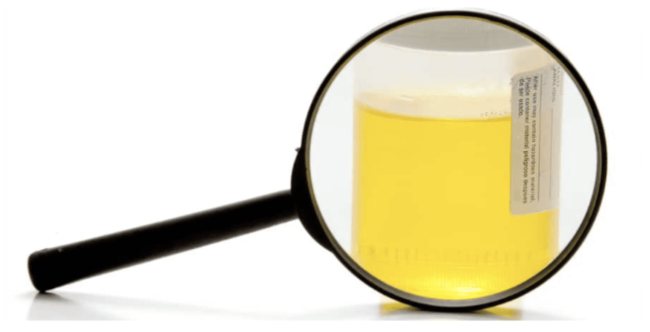
Where and how to properly store urine until the morning?
If no more than 2 hours have passed from the moment of collection to delivery to the laboratory, then the errors in the indicators will not be significant. The longer the biomaterial is stored, the more the accuracy of the data obtained suffers.
Important! If urine has stood for a day, then regardless of the conditions in which it was kept, it is in no way suitable for analysis.
Depending on the type of analysis, urine can be stored:
- 24-hour urine is so called because it is collected over a 24-hour period. In this case, storage is permissible during this entire time in the refrigerator, but not in the freezer.
- If a general analysis is prescribed, the fluid is collected in the morning and immediately delivered to the laboratory. It cannot be stored for more than 1 hour.
- For a three-glass sample, urine can be kept for no more than 1 hour at room conditions. The collection takes place in the morning.
- The Zimnitsky analysis involves collecting urine per day, 8 times in separate containers. They are kept in the refrigerator for no more than a day. This type of cooling is acceptable. The addition of preservatives is also permitted.
- For the range of studies on Nichiporeno, urine is not cooled at all, this is prohibited. After morning urination, she should be delivered to the laboratory no later than an hour later.
A refrigerator will help extend the shelf life of urine for analysis, but provided that the material is not cooled below +4 degrees. You cannot freeze the liquid, this will completely change it.
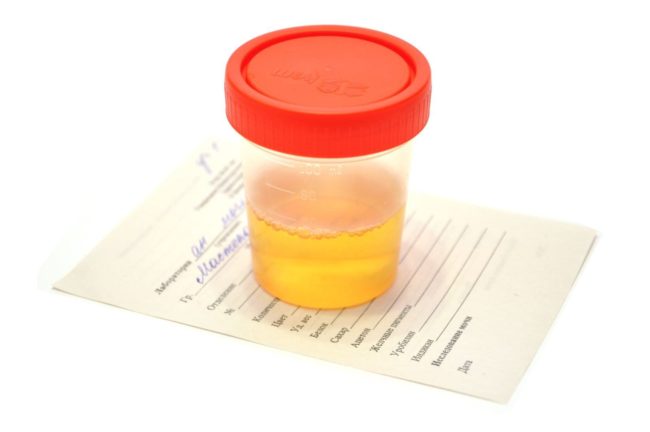
Impact on the accuracy of analysis results
Material collected from a child cannot be kept in the refrigerator for as long as that taken from an adult: after a short time, ammonia forms in the child’s urine. The presence of this substance may indicate a non-existent pathology.
The doctor who has issued a referral for a test in the laboratory must explain to the patient how long samples can be stored and under what conditions.
The following factors may affect the accuracy of the results:
- entry into the container of environmental elements, bacteria, and other foreign substances;
- if the child is not washed before collection, microorganisms accumulated on the external genitalia can spoil the results;
- incorrect content: more than 120 minutes at room temperature and more than 24 hours in the refrigerator.
Each method of laboratory research has its own algorithm for collecting urine: for example, for a general analysis it is recommended to collect the middle stream, and for identifying the hCG level - the first.
Is it possible to store urine for longer than the specified time?
Freshly collected urine is the best option for analysis, but it is not always possible to correctly collect and store it. Tests are often prescribed for children, infants, and patients who have serious problems with urination.
The work schedule also makes its own temporary adjustments. In these cases, it is worth remembering that the container with urine can be kept in the refrigerator for a certain time. There it should only cool down a little, but not start to freeze. The optimal temperature to preserve the properties of the material is +4 degrees. Such conditions in the refrigerator are created on the doors or on the shelf at the very bottom of the chamber.
Important! If the urine has been stored in the refrigerator since the evening, this point should be indicated to the laboratory assistant.
In some cases, to determine the full picture of the disease, patients need to collect all their urine per day. In this case, there is no way to do without storing it for more than 2 hours. Special preservatives will help preserve the properties of urine.
The following substances can be added:
- Acetic acid (glacial). No more than 5 ml of liquid for the entire volume of urine collected per day.
- Toluene. Use no more than 2 ml for the entire container. Such a substance can lead to sediment after several hours.
- Boric acid. Add in the following doses: for every 100 ml, 3 granules.
- Thymol. Use 2 crystals per 100 ml volume of urine.

